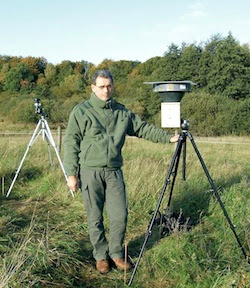Zebra Stripes Evolved to Repel Bloodsuckers?
Conventional wisdom says a zebra's black-and-white stripes camouflage the animal in tall grass—the better to evade the colorblind lion. But a new study says the pattern scrambles the vision of a tinier biter: the bloodsucking horsefly.
Effect of zebra stripes on horseflies
In a relative sense, zebra stripes repel horseflies. That’s the latest discovery reported by Gábor Horváth [pictured here], who discovered that white horses attract fewer flies, and that Vikings knew a thing or two about how to use light for ship navigation. For details, see the study:
In a relative sense, zebra stripes repel horseflies. That’s the latest discovery reported by Gábor Horváth [pictured here], who discovered that white horses attract fewer flies, and that Vikings knew a thing or two about how to use light for ship navigation. For details, see the study:
“Polarotactic tabanids find striped patterns with brightness and/or polarization modulation least attractive: an advantage of zebra stripes,” Ádám Egri, Miklós Blahó, György Kriska, Róbert Farkas, Mónika Gyurkovszky, Susanne Åkesson and Gábor Horváth, Journal of Experimental Biology, vol. 215, March 2012, pp. 736-745.
“The characteristic striped appearance of zebras has provoked much speculation about its function and why the pattern has evolved, but experimental evidence is scarce. Here, we demonstrate that a zebra-striped horse model attracts far fewer horseflies (tabanids) than either homogeneous black, brown, grey or white equivalents.”
BBC Nature - Zebra stripes evolved to keep biting flies at bay
Coloured images revealed how light was polarised as it bounced off a zebra's coat
"We created an experimental set-up where we painted the different patterns onto boards," Dr Akesson told BBC Nature. She and her colleagues placed a blackboard, a whiteboard, and several boards with stripes of varying widths into one of the fields of a horse farm in rural Hungary."We put insect glue on the boards and counted the number of flies that each one attracted," she explained.The striped board that was the closest match to the actual pattern of a zebra's coat attracted by far the fewest flies, "even less than the white boards that were reflecting unpolarised light," Dr Akesson said."That was a surprise because, in a striped pattern, you still have these dark areas that are reflecting horizontally polarised light."But the narrower (and more zebra-like) the stripes, the less attractive they were to the flies." To test horseflies' reaction to a more realistic 3-D target, the team put four life-size "sticky horse models " into the field - one brown, one black, one white and one black-and-white striped, like a zebra. The researchers collected the trapped flies every two days, and found that the zebra-striped horse model attracted the fewest.
Related
- Zebra - Wikipedia, the free encyclopedia
- HOW THE ZEBRA GOT ITS STRIPES
- Polarotactic tabanids find striped patterns with brightness and/or polarization modulation least attractive: an advantage of zebra stripes
- Mystery of Zebra's Stripes Finally Solved? - ScienceNOW
- How the zebra got its stripes
- How the zebra got its stripes › News in Science (ABC Science)
- Zebras' stripes tell nasty flies to buzz off - CBS News
- How The Zebra Got Its Stripes : Discovery News
- Zebras' Stripes Tell Nasty Flies to Buzz Off | LiveScience
- Bootylicious Fly Gets Named Beyoncé | Beyoncé Horse fly, Animals Named After Celebrities & New Species | LiveScience


